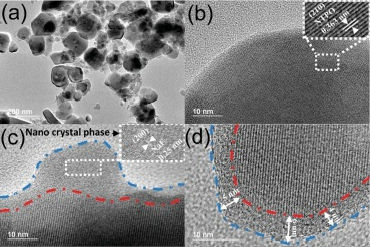

The review article by researchers at the University of São Paulo shows the advantages of this technological alternative, which is nontoxic and much cheaper than other methods (transmission electronic microscopy image of sodium dititanium tris(phosphate) before (A e B) and after (C e D) 421 galvanostatic charge and discharge cycles at 0.2 C-rate (full charge/discharge in five hours) / Current Opinion in Electrochemistry)
The review article by researchers at the University of São Paulo shows the advantages of this technological alternative, which is nontoxic and much cheaper than other methods.
The review article by researchers at the University of São Paulo shows the advantages of this technological alternative, which is nontoxic and much cheaper than other methods.

The review article by researchers at the University of São Paulo shows the advantages of this technological alternative, which is nontoxic and much cheaper than other methods (transmission electronic microscopy image of sodium dititanium tris(phosphate) before (A e B) and after (C e D) 421 galvanostatic charge and discharge cycles at 0.2 C-rate (full charge/discharge in five hours) / Current Opinion in Electrochemistry)
By José Tadeu Arantes | Agência FAPESP – Highly concentrated aqueous electrolytes, known as water-in-salt electrolytes, could be an alternative to the organic solvents used in car batteries and other electrochemical devices. Abundance and, hence, low cost are key factors in this application, alongside nontoxicity, according to the review article “Water-in-salt electrolytes for high voltage aqueous electrochemical energy storage devices” published in the journal Current Opinion in Electrochemistry by Vitor Leite Martins and Roberto Manuel Torresi, both of whom are affiliated with the University of São Paulo’s Chemistry Institute (IQ-USP) in Brazil.
The study was conducted as part of Martins’ postdoctoral research supervised by Torresi and part of the Thematic Project “Optimization of the physicochemical properties of nanostructured materials for applications in molecular recognition, catalysis and energy conversion/storage,” for which Torresi is principal investigator. Both projects are supported by FAPESP.
“The term ‘water-in-salt electrolytes’ refers to solutions constituting a very high concentration of salt in a very small amount of water. The amount of water is just sufficient to dissolve the ions to promote solvation. The system contains no free water, unlike conventional solutions,” Torresi told Agência FAPESP.
This is possible only if the salt molecule to be dissolved comprises a large anion and a small cation, Torresi explained. An example is LiTFSI, i.e., lithium bis(trifluoromethane sulfonyl)imide (CF3SO2NLiSO2CF3), whereas NaCI, i.e., sodium chloride or table salt, is of no use, as it has an anion and cation of similar sizes.
“Because there’s no free water in this ultraconcentrated solution, electrolytic splitting of water into hydrogen and oxygen becomes far more difficult, so the electrochemical stability of the solution is very high despite the system containing water,” he said.
In summary, this innovative technological proposal based on a high concentration of salt in water offers significant advantages over conventional technology using salt dissolved in organic compounds. Nevertheless, the technological use of water-in-salt electrolytes also presents challenges.
“The first is that the solution contains little water and is highly hygroscopic: it tends to absorb moisture from the air, and this changes its water content. The second is that ultraconcentrated aqueous solutions are highly corrosive,” Torresi said.
The propensity to absorb ambient moisture is shared with organic solvents and is one of the reasons why conventional batteries have to be shielded, but corrosiveness is a major disadvantage: the organic solvents currently used in lithium batteries do not attack the electrodes, the only metallic components, to a significant extent.
However, according to Torresi, this drawback should not be overestimated. “Corrosion was a major issue for decades. Now, we know how to refine current collectors, and with a few adaptations, it won’t be hard to surmount the problem of corrosion in a future aqueous battery,” he said.
The article “Water-in-salt electrolytes for high voltage aqueous electrochemical energy storage devices” can be retrieved from www.sciencedirect.com/science/article/abs/pii/S245191032030013.
Republish
The Agency FAPESP licenses news via Creative Commons (CC-BY-NC-ND) so that they can be republished free of charge and in a simple way by other digital or printed vehicles. Agência FAPESP must be credited as the source of the content being republished and the name of the reporter (if any) must be attributed. Using the HMTL button below allows compliance with these rules, detailed in Digital Republishing Policy FAPESP.





